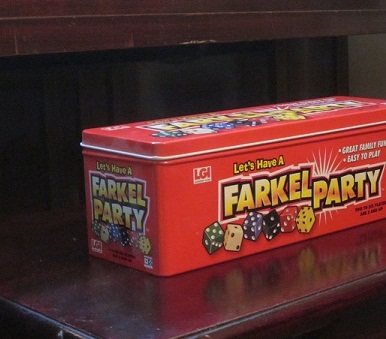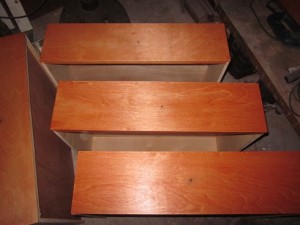Hello, Vegas? Give me 100 bucks on red . . . D’oh! All right, I’ll send you a check.
– Homer Simpson
There are two ingredients needed to match existing trim in an old house: gel stain and patience. Unless the woodwork is painted, in which case you need paint and patience. I’ve mentioned that patience is a tough one for me, but I have my stain matching technique down now. It’s easier taking the time when I know it’s going to work out. (Learn more about gel stain here.)
Many older homes (including Chez D’oh) have dark, reddish woodwork. Early on, when patching or replacing, I tried to match using a single, red-based stain. This was typically a major stain brand’s “mahogany” of some description. The depth of the color usually ended up ok, but the tone was always off.
Reds can tend to the yellow/orange end or the blue/purple side. The matching issue with most mahogany stains I’ve found is that they lean towards purple. The woodwork in this house is red-brown, but the underlying red is an orange-red. The difference is apparent when I put a red-red next to each type of finish (RED courtesy of the Farkel Party tin).
If you are trying to match woodwork, take the time to figure out what tones go into what you have. We’ve got brown/red-orange, and I use layered gel stains to achieve a match. This week, I’m applying my recipe to the storage bed to carry the trim color into the bedroom (where the woodwork is otherwise painted).
I’ve already prepped the drawers for stain. The bed is pine, so I used wood conditioner to prevent blotchiness; you don’t necessarily need wood conditioner for gel stain, but pine is tricky and it’s a quick step.
Step 1: Start with a base of your undertone. I use Varathane gel stain in Traditional Cherry to establish an orangey base.
I lay down two or three coats of this; it gets REALLY orange.
Step 2: Add dimension. Typically, older wood’s grain is the darkest part of the finish. When you are staining newer wood of a different species, you can end up with the grain showing up lighter or looking kind of flat. I deal with this by doing a light layer of Spanish Oak gel stain. I have the Old Masters version, and it’s almost black. (What is it they do in Spain to oak to make it so dark that it’s a known stain color?) I work it against the grain and then wipe (quickly!) with the grain to give the piece a little age and depth.
Step 3: Add the main covering color until you get a match. After Step 2, things don’t look very promising, but this last color step will get you there. To get from dirty orange to vintage woodwork, I layer General Finishes gel stain in Brown Mahogany. Unlike Minwax’s Bombay Mahogany or Old Masters’ Vintage Burgundy, this is a more neutral dark red-brown. “Neutral red-brown” may not make a lot of sense, but what I mean is that it doesn’t go violet or super-orange on you. It’s a nice, deep color.
I layer the Brown Mahogany (and layer and layer) and buff (and buff and buff) until I have a good match. It’s not going to necessarily be a perfect match on a different wood species, but you can get close. I put the drawers in front of existing woodwork to check the match in different lights.
If you figure out all the tones, this layering technique works to match any complex stain color. In one sense, gel stain is almost like faux painting — it doesn’t sink in as much as deposit color on the surface. But it’s easy to control and use to build up a match.
If you have an “oops!” moment, it’s not as hard to fix as traditional stains that really sink in. Give it a try!










